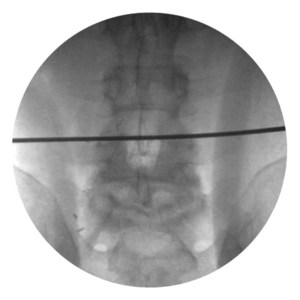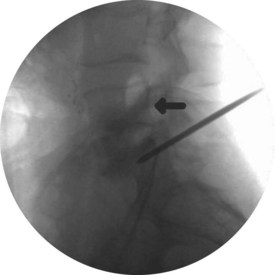Procedure 37 Minimally Invasive Exposure Techniques of the Lumbar Spine
Indications
 Conditions requiring decompression of the lumbar spine, wherein a minimally invasive surgery (MIS) technique is desired
Conditions requiring decompression of the lumbar spine, wherein a minimally invasive surgery (MIS) technique is desired
Examination/Imaging
 Although it is difficult to define the exact boundaries of a percutaneous, mini-open, or traditional “open” surgery, the application of less invasive spinal surgery principles is much more important than the length of the skin incision (Jaikumar et al, 2002; Lehman et al, 2005).
Although it is difficult to define the exact boundaries of a percutaneous, mini-open, or traditional “open” surgery, the application of less invasive spinal surgery principles is much more important than the length of the skin incision (Jaikumar et al, 2002; Lehman et al, 2005).
 The most important aspect to the success of spinal surgery is proper patient selection.
The most important aspect to the success of spinal surgery is proper patient selection.
 Before surgery, the surgeon should carefully study the imaging studies (plain radiographs, magnetic resonance imaging [MRI] and/or computed tomography [CT]) and develop a surgical plan, including an optimal workflow for the procedure.
Before surgery, the surgeon should carefully study the imaging studies (plain radiographs, magnetic resonance imaging [MRI] and/or computed tomography [CT]) and develop a surgical plan, including an optimal workflow for the procedure.
 Evaluation of imaging is critical, because all relevant pathologic features must be visualized and addressed to achieve results comparable or superior to an open operation.
Evaluation of imaging is critical, because all relevant pathologic features must be visualized and addressed to achieve results comparable or superior to an open operation.
 Patients with severe osteopenia, obesity, or intraabdominal contrast may be impossible to adequately image with the C-arm. If adequate fluoroscopic images cannot be obtained, an alternative surgical strategy should be employed.
Patients with severe osteopenia, obesity, or intraabdominal contrast may be impossible to adequately image with the C-arm. If adequate fluoroscopic images cannot be obtained, an alternative surgical strategy should be employed.
 When setting up for percutaneous pedicle instrumentation, the vertebrae should be aligned so that, on an anteroposterior (AP) image, the spinous process is centered between the pedicles, and the superior end plate is parallel to the fluoroscopy beam (the true AP view) (Figure 37-1).
When setting up for percutaneous pedicle instrumentation, the vertebrae should be aligned so that, on an anteroposterior (AP) image, the spinous process is centered between the pedicles, and the superior end plate is parallel to the fluoroscopy beam (the true AP view) (Figure 37-1).
 On the fluoroscopic lateral image, the pedicles should be superimposed, and only a single posterior cortex of the vertebral body should be seen (Figure 37-2, arrow). The edges of the superior end plate should be superimposed, forming a single radiopaque line.
On the fluoroscopic lateral image, the pedicles should be superimposed, and only a single posterior cortex of the vertebral body should be seen (Figure 37-2, arrow). The edges of the superior end plate should be superimposed, forming a single radiopaque line.
Treatment Options
• The alternative to any MIS procedure for the lumbar spine is traditional open surgery.
• With experience, MIS can be applied to essentially all degenerative conditions; however, because certain clinical situations may arise that preclude the completion of the surgery with a minimally invasive approach, the surgeon should always be prepared to extend the incision if required to adequately address the spinal pathology.
Surgical Anatomy
 The radiographic position of all relevant anatomy should be undertaken before making the initial incision.
The radiographic position of all relevant anatomy should be undertaken before making the initial incision.
 The incision should be positioned to allow optimal access to the surgical pathology.
The incision should be positioned to allow optimal access to the surgical pathology.
 The skin and fascia should be sharply divided.
The skin and fascia should be sharply divided.
 The muscle tissue should be gently traversed, working between the muscle planes or between muscle fascicles.
The muscle tissue should be gently traversed, working between the muscle planes or between muscle fascicles.
 The tubular retractor should be docked to the spine to minimize the need to resect muscle tissues to visualize the bony anatomy.
The tubular retractor should be docked to the spine to minimize the need to resect muscle tissues to visualize the bony anatomy.
 The bony landmarks should be identified before the resection of any bone.
The bony landmarks should be identified before the resection of any bone.
 Care should be taken to preserve an adequate amount of the pars interarticularis and inferior articular process if a fusion of the operative level is not planned.
Care should be taken to preserve an adequate amount of the pars interarticularis and inferior articular process if a fusion of the operative level is not planned.
 When working in the spinal canal, the epidural fat is a useful clue to localize the plane beneath the ligamentum flavum, adjacent to the dura.
When working in the spinal canal, the epidural fat is a useful clue to localize the plane beneath the ligamentum flavum, adjacent to the dura.
 The pedicle is a key landmark to assist the surgeon in localizing the position within the spinal canal. By palpating the pedicle, the surgeon can gauge the amount of bony resection and can also localize migrated disk fragments.
The pedicle is a key landmark to assist the surgeon in localizing the position within the spinal canal. By palpating the pedicle, the surgeon can gauge the amount of bony resection and can also localize migrated disk fragments.
 The exiting and traversing nerve root should be decompressed as needed, depending on the nature of the patient symptoms and pathology.
The exiting and traversing nerve root should be decompressed as needed, depending on the nature of the patient symptoms and pathology.
Surgical Anatomy Pearls
• Careful fluoroscopic localization of the surgical incision is mandatory before making the incision.
• A spinal needle inserted along the proposed trajectory of the surgical incision can be used to check the location of the incision using fluoroscopy.
• Careful palpation of surgical planes is useful before using a Kerrison instrument to remove bone from the region of the spinal canal.
Positioning
 For posterior procedures (microdiskectomy, lumbar decompression, PLF, PLIF, TLIF etc.), the patient should be positioned prone on a radiolucent spinal table or frame.
For posterior procedures (microdiskectomy, lumbar decompression, PLF, PLIF, TLIF etc.), the patient should be positioned prone on a radiolucent spinal table or frame.
 The abdomen should be free of compression (Lehman et al, 2005; Seldomridge and Phillips, 2005).
The abdomen should be free of compression (Lehman et al, 2005; Seldomridge and Phillips, 2005).
 Careful padding of all vital and bony regions should be confirmed.
Careful padding of all vital and bony regions should be confirmed.
 Access for fluoroscopy should be confirmed in the operative position.
Access for fluoroscopy should be confirmed in the operative position.
 Access for the operative microscope should be confirmed.
Access for the operative microscope should be confirmed.
 For anterior procedures, the abdomen should be widely draped with access from the xiphoid to the pubis.
For anterior procedures, the abdomen should be widely draped with access from the xiphoid to the pubis.
 For lateral interbody fusion procedures (XLIF, DLIF) the patient should be secured in a “true” lateral position with a slight lateral bend to the lumbar region (away from the operative incision) to improve access to the lateral aspect of the vertebral body.
For lateral interbody fusion procedures (XLIF, DLIF) the patient should be secured in a “true” lateral position with a slight lateral bend to the lumbar region (away from the operative incision) to improve access to the lateral aspect of the vertebral body.
General Aspects to Posterior Tubular Retractor Surgery
 The learning curve for MIS techniques must be acknowledged and planned for.
The learning curve for MIS techniques must be acknowledged and planned for.
 Reconstructive procedures (Figure 37-3) are more difficult compared with decompressive procedures and should be approached farther along the learning curve of the individual surgeon. Additional time should be allotted for surgical cases in the early portion of the surgeon’s learning curve.
Reconstructive procedures (Figure 37-3) are more difficult compared with decompressive procedures and should be approached farther along the learning curve of the individual surgeon. Additional time should be allotted for surgical cases in the early portion of the surgeon’s learning curve.
 The first surgical step is to localize the precise site for all skin incisions using fluoroscopy (Seldomridge and Phillips, 2005).
The first surgical step is to localize the precise site for all skin incisions using fluoroscopy (Seldomridge and Phillips, 2005).
 The use of an expandable tubular retractor system allows a more generous exposure but has the trade off of increased tissue dissection and soft tissue creep.
The use of an expandable tubular retractor system allows a more generous exposure but has the trade off of increased tissue dissection and soft tissue creep.
 Although the instruments used for minimally invasive spine surgery (MISS) procedures are similar to those used with traditional open procedures, longer, bayoneted instruments are useful to ensure that visualization is not obscured by the surgeon’s hands.
Although the instruments used for minimally invasive spine surgery (MISS) procedures are similar to those used with traditional open procedures, longer, bayoneted instruments are useful to ensure that visualization is not obscured by the surgeon’s hands.






